Give a man a fish, you feed him for a day. Teach a man to fish and you feed him for a lifetime.
Humans have been fishing since before the dawn of civilization. And it’s no wonder. Fish are nutritious and, dare I say, delicious. Plus, they’re plentiful, almost all are edible, and you can find them in just about every body of water coast to coast.
While you could spend thousands of dollars on top-of-the-line fishing gear, you don’t need any of those bells and whistles. Heck, in dire straights, you can find everything you need right on the forest floor. Or even a city street.
Plus, fishing is one of the best ways to get protein in a survival situation. And it’s easy and fast if you know what you’re doing. Lucky for you, the basics of survival fishing are simple to learn and you’ve got me here to explain them to you.
Content
Benefits of Survival Fishing
If you’re concerned about wilderness survival, then there are plenty of reasons to learn to fish. Fishing can help you survive whether it’s an unexpected emergency, like getting lost, or during a long-term SHTF scenario.
While finding food should never be your first priority (it’s topped by making a shelter, building a fire, and finding water), it is important. Finding food provides you with the calories you need to keep your energy and not fatigue. What’s more, having a full belly improves your attitude, which means a lot in a survival scenario.
When you know how to fish, you can provide food for you and your family. One successful fishing trip can provide enough for two or more meals. Even in an urban environment, survival fishing can keep food on the table.
The best benefit of survival fishing is that you can do it with minimal effort. At times, it can even become a passive way to get food.
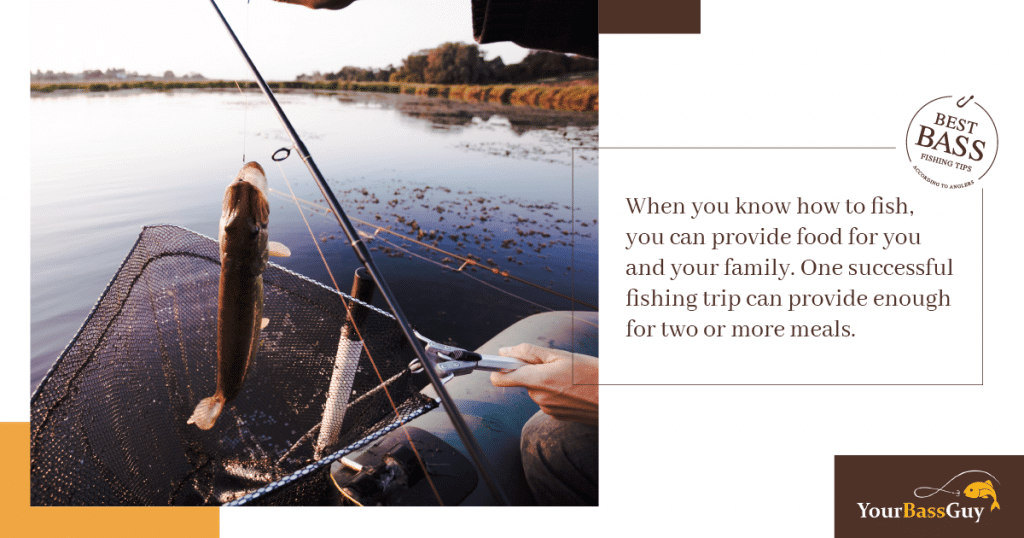
Survival Fishing Techniques
Note: Before we continue, know that some of the techniques I’m going to share are illegal in the United States. I’m sharing them so that in a true survival situation, you’ll know what to do.
When catching fish in survival mode, you need to think a little differently about fishing. Sure, you can fish with a rod and reel, but for the long-term, you’ll want something that doesn’t require so much of your time. Called passive fishing, it involves you setting the stage and coming back to reap the harvest. We’ll discuss these different methods in a moment.
In long-term survival, you also want more than a reliable fishing spot. You want a place where you can collect fish and keep them alive until you want them. Lastly, when you’re in a survival situation, you need to maximize your chance of catching fish. That means implementing more than one strategy and continually monitoring them for success.
Keep those things in mind as we discuss the different ways to catch fish.
Setting Multiple Fishing Lines
Assuming you don’t have a survival fishing pole, you’ll want to create your own make-shift fishing pole. But don’t make one of them. Make several. Start with a strong stick or willow reed and tie a fishing line to it. Fit the line with a few sinkers and a hook. Bait the hook then drop a line in the water.
If you’d like to go more in-depth with this, take a look at our article on “how to make a fishing rod.”
If you want to increase your chances, don’t drop one line, drop as many as you can. You can push the stick into the ground of the side of the riverbank to hold it in place. If there are low hanging branches over the water, forget the sticks and tie your fishing line to the tree branch. Place as many of these as you can on different branches to improve your odds of catching dinner.
Trotline
A trotline is a passive way to catch fish that doesn’t require your undivided attention. You want to find a narrow point in a river or creek that’s shallow, but not too shallow. If there’s cover nearby, even better.
Take a length of paracord and tie it from a tree branch on one side of the water to a tree branch on the opposite bank. This is your control line. Take sections of the fishing line and tie them to the control line.
Make them long enough that they hang a few inches or more into the water. Attach a hook to each of these leader lines and bait it. Tie the lines every foot or so across the control.
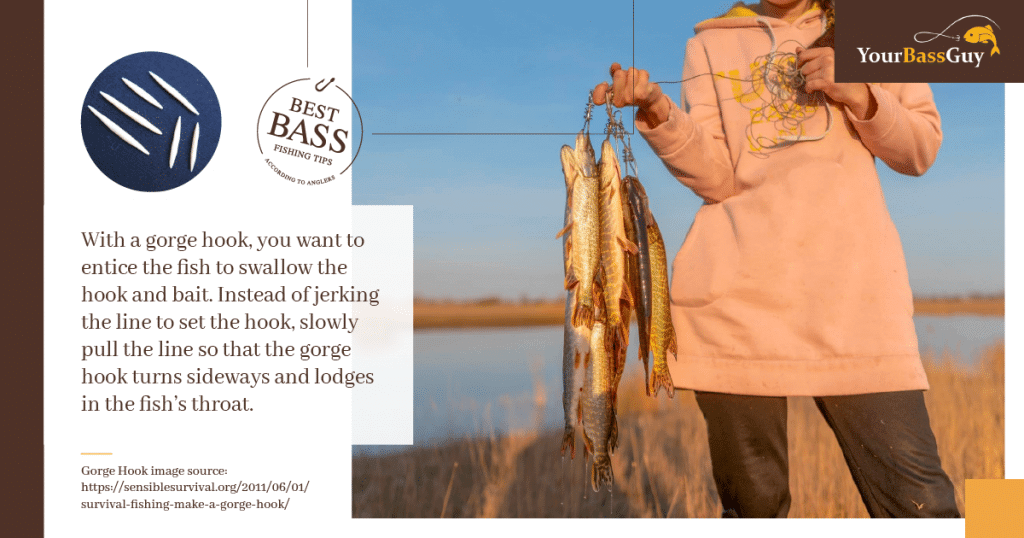
Gorge Hooks
Using a gorge hook isn’t like fishing with a traditional bent hook. Instead, these hooks are straight and about one inch in length. You can make them from just about anything hard, including bones, twigs, and pieces of hard plastic. Sharpen it on both ends and have a notch in the middle where the fishing line secures to the gorge hook.
With a gorge hook, you want to entice the fish to swallow the hook and bait. Instead of jerking the line to set the hook, slowly pull the line so that the gorge hook turns sideways and lodges in the fish’s throat. You then pull the fish toward you and capture it in a net.
Catching Fish With a Net
Another way to catch fish in a survival situation is with a fishing net. You can make a survival fishing net with green wood found inside sapling trees. You can even improvise with a piece of cloth tied to two sticks.
Wade through the water, slowly and calmly, toward the shore. When you get to shallow water, lift the net to reveal your catch. This also can be an effective way to catch small fish like minnows for bait for large fish.
Hand Fishing
You can even fish when you have absolutely no equipment. Hand fishing, which is also called noodling, graveling, or hogging, is a primitive, backcountry fishing technique.
It involves grabbing the fish directly from its hiding spot with your hand. It’s most often seen when fishing for catfish and suckers, who like to hide in dark places like hollow logs, undercut banks, and holes under rocks.
You start by blocking the hole, then slowly reach inside. Once you touch the fish, slide your hand along its side until you can grab the mouth or gills. Grip tight and pull the fish out. Beware of the catfish’s barbels, which fan out around its mouth. These barbs can sting, causing pain and irritated skin.
Spearfishing
Spearfishing requires a fishing spear that you can make from a strong piece of wood, bone, or metal by adding a sharpened, barb-pointed end. This survival fishing method takes practice, so don’t get discouraged.
When fishing with a spear, be sure to compensate for light refraction and aim below the fish. Try spearfishing at night by torchlight, where you won’t cast shadows into the water, alerting the fish of your presence.
Striking
Some larger fish are slow, which may make them easy prey. You can stun these fish by hitting them with a hard stick or club. Although crude, this method can provide you with dinner when you need it.
Fish Traps
A survival fish trap is an easy and passive way to catch fish. Start with a container and fashion an inverted funnel that opens up into it. The idea is that the fish swim through the funnel and into the trap then can’t figure out how to get out.
Be sure to make your trap big enough to capture the size of fish you’re trying to catch. You can also use this style of trap to catch minnows and fish fry for bait. A pop bottle with the top removed and inverted to create a funnel can be highly effective.
Fishweir
A fishweir is a fence or wall that lures fish where you want them to go. Most often this is to a small pool or your survival fish trap where the fish can stay alive until you need them.
Make your own weir by piling rocks or driving stakes side by side to make a fence-like barrier. You can also use the weir to gather fish for spearing or catching with a net. In some cases, you may even be able to catch them by hand.
Start at one bank and place your rocks or sticks as close as possible, creating a screen that stretches to the other bank. The only opening should go to your trap or pool. The water flows freely through this screen and the fish won’t notice that obstruction. Instead, they’ll follow along the fish wall and end up exactly where you want them.
Stunning Fish
Lastly, and probably my least recommended, is stunning fish. This survival fishing technique relies on poison to stun the fish.
Use mullein or buckeye (plants common in the US), both of which contain properties that stupefy fish. Crush parts of the plants, including the flowers, stems, and roots, as well as the buckeye nuts, and drop them into shallow pools of water where fish live. You can use other natural poisons, like the husks from young walnuts or lime (which you make by burning, then crushing mussel shells).
Practice Survival Fishing
The final survival fishing technique is to practice. Then practice some more. You can read blog posts (like this one) and watch YouTube videos, but it doesn’t give you the actual survival skills you need. Only experience does that. So get out there and start looking for good fishing areas. Get a line in the water and catch a few fish.
Because it’s easier to do things when you’re not in a survival scenario. When you’ve eaten more than a few nuts and berries and your seven-year-old isn’t crying because he’s so hungry.
Learn what you can NOW so that if an emergency happens, you can handle it with less stress and worry. Remember, once you know how to fish, you can almost always find food.

Know Where to Survival Fish
While finding dinner is important, so is staying safe. Depending on what type of SHTF situation you’re in, you may want to avoid places that force you out in the open. And those that have a surplus of people trying to fish.
Pay attention to the waterways around where you live. Are there streams and rivers? You can also find ponds in parks, natural reserves, golf courses, and farms. Watch these bodies of water to determine which are home to fish, frogs, and crawdads. All of these could feed you in an emergency.
How to Choose the Right Spot for Catching Fish After SHTF
The biggest angler secret to finding fish is to think like a fish. And the first thing to know about how fish think is that they like cover. Cover consists of things that cover the water, providing hiding spots.
These can include structures in or out of the water like rocks, trees, brush, logs, and weeds. It also includes manmade structures like docks, drain pipes, and seawalls. Even trash that’s gathered in the water provides cover for fish.
Don’t forget to look for natural underwater covers like undercut river banks, caves carved from rocks, or underwater ledges. Just be careful. You can’t help anyone survive if you break a leg when a shoreline collapses.
Other places to look for fish include:
- Areas of change. Look for changes in the water, a rise of a lake bottom, or even a drop in water depth.
- Places where water pools or becomes still. Look behind fallen trees and large rocks.
- Where waterways meet. Look where small streams flow into rivers or lakes, which often have more oxygen and cooler water.
- Deep holes. Look for deeper holes in lakes and rivers where fish hide in the darker, deeper water.
Understand What Impacts Fishing and How Fish Feed
Natural elements affect fish, including the time of day, weather, and seasons. And if you’re fishing during a survival situation, the elements can impact your success.
Fish feed most before dawn and within the first hour of daylight, making it the prime time to have a line in the water. The second most productive time of day to fish is right after dusk when they again feed heavy.
In the spring, fish are easiest to catch, especially if you live somewhere that has a cold winter. In these areas, the fish are hungry and active due to the warmer water. Many are also laying their eggs near shore in the spring, so opt to drop your line in covered, shallow water.
In summer, fish often prefer the deeper waters where it’s cooler. Move away from the shore and try to hit the deep holes or still water in the shade. In the fall, the water temperature starts to drop, spurring fish to increase their food intake.
This means they may be more interested in your bait. During winter, fish stay in deeper waters, away from the ice on the surface. Be sure to have a deep enough line that the fish can find your hook.
Barometric pressure also impacts fish and many go into a feeding frenzy before a storm. When the storm includes a cold front, the amount a fish eats can slow down until after the cold snap passes. On this same note, a bit of wind can increase your odds when you’re fishing for survival.
Strong winds make waves that interfere with the fish’s ability to see out of the water. Windy weather also stirs up sediment, making the water cloudy and the fish less likely to spook.
Approach Your Survival Fishing Spot
So by now, you have your fishing spot picked out, depending on the season and where the fish are. But I want to warn you, don’t go stomping up to the lakeshore in a neon shirt with a radio blasting. No, approach your fishing spot like you would a hunting spot, slowly and quietly. Even softly, as fish feel vibrations coming from the shore and could spook.
Also, know that fish can see out of the water, so be aware of casting your shadow over where you want to fish. Remove anything metallic or shiny so that it doesn’t create a reflection in the water.
Although you don’t need to dress in camo (but you can), know that bright, solid colors can spook fish. Consider wearing natural hues and patterns. If that’s not possible, hide in the brush or tall grass to mask the solid mass of color.
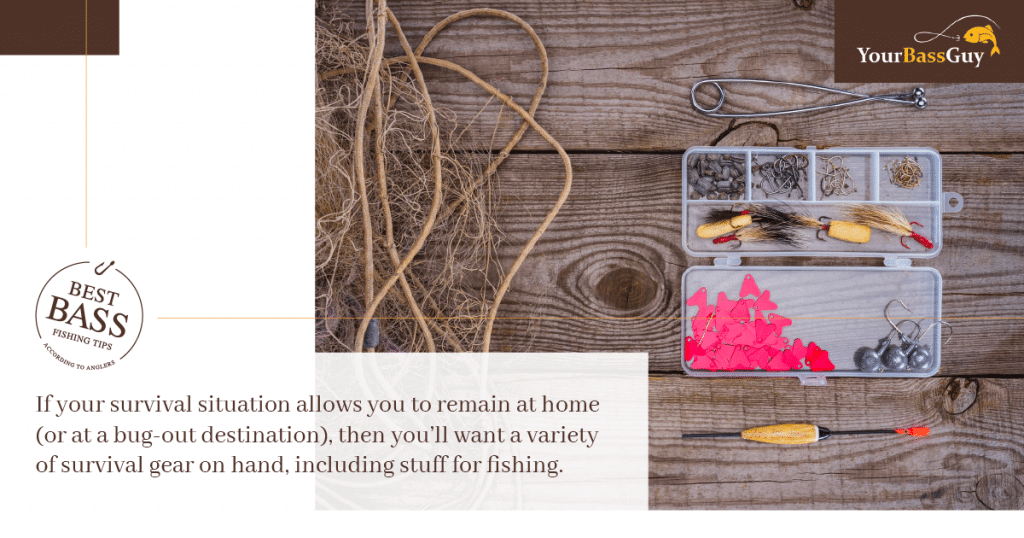
Survival Fishing Gear
In a perfect survival situation, you have everything you need in top-quality survival gear. The right pole, the right reel, some comfy shoes, and a tackle box stocked with exactly the right equipment and supplies. While survival situations rarely work out that way, let us pretend for a moment that they do and take the opportunity to discuss what is the best-case scenario in fishing gear for the post SHTF fisherman.
Survival Fishing Pole
There are a lot of variables in finding the best survival fishing pole, including where you’re located, the types of water available, and even the time of year. But a good telescopic fishing rod could accommodate almost any fisherman’s needs.
We recommend a telescopic fishing rod because you should opt for a pole that’s compact enough it doesn’t take up too much space, but large enough to handle a fair-sized fish. Versatility, as well as durability, are also qualities to look for.
Survival Fishing Reel
When it comes to survival fishing reels, there is just as much variance as with fishing poles. The most important aspects of your survival fishing reel are that it’s compact enough to carry with ease, yet dependable enough that you can rely on it when you need dinner.
Speaking of dependability, you want a reel that works well in YOUR hands. Which means you need to fish with it and get the feel of it. Don’t just go out and buy one to stick it in a bag and never use it. Becoming familiar with your survival fishing equipment, and especially your reel, can mean the difference between a full belly and an empty one.
Survival Fishing Hooks
Perhaps the most important thing when it comes to survival fishing hooks is that they need to reliably set in a fish’s mouth. If you need dinner and you can’t set the hooks that you haphazardly threw in your survival fishing kit, guess who’s going to bed hungry.
You also want a strong hook that can withstand the tests of repeated fishing. After all, these hooks won’t be easy to replace so you need to make sure they’re as durable as possible. And regardless of what style of survival fishing hook you decide on, purchase several sizes. If it’s a true TEOTWAWKI scenario, you may end up fishing all sorts of different locations and a variety of species of fish.
Survival Fishing Kit
Let’s take a moment and talk about a survival fishing kit. There are three different situations when it comes to survival fishing. The first is when you have a prepared home base. The second is when you’re on the move and functioning out of a bug-out bag. And the third is when you’re in an emergency situation and you have nothing with you but what’s in your pockets.
At-Home Fishing Survival Kit
If your survival situation allows you to remain at home (or at a bug-out destination), then you’ll want a variety of survival gear on hand, including stuff for fishing. These items aren’t necessary to survival fishing, but they do make the experience easier.
At home, keep the following items on hand for a SHTF situation:
- Over-the-shoulder fishing bag or backpack
- Small tackle box that with hooks, jigs, sinkers, spinners, grubs, rubber worms, and lures
- Jars of salmon eggs
- Multitool with pliers
- Fillet board
- Fillet knife
- Gill net
- Hand net
- At least one rod that breaks down for easy carry
- Plenty of braided 10-pound fishing line
- Ice fishing supplies
Although braided fishing line is more expensive, it’s worth the investment. Monofilament line (what’s found in store-bought survival fishing kits) deteriorates over time and becomes weak. In a true survival situation, you may have to use your line over and over again and need to rely on it to stay strong.
Bug-out Bag Fishing Kit
You should also keep a small fishing kit with the essentials in your bug-out bag. You can easily contain everything you would need in something as small as an Altoid tin. In this small survival fishing kit include:
- Braided 10-pound test fishing line
- 40-50 hooks between size #12 and #8
- A few sinkers and swivels
- A few artificial lures and rubber worms
This list assumes you have a fully-packed prepper bug-out bag with a knife, multitool, and paracord. Also, we can never neglect the importance of survival medicine. If you ever find yourself injured due to improper knife usage, you’ll be glad you read this stab wound article by Joe Alton MD.
If there’s a bug-out bag in your vehicle, add a collapsible survival fishing pole. It’s not worth the space in your bug-out bag but can serve you well in a vehicle.
How to Catch Fish Without Equipment
When it comes to survival fishing, you should also know what to do when you have none of the above. If you don’t have a survival fishing kit, but come across water and want to fish, here’s what you do.
Create a fishing hand line from whatever you have. It can be from fabric strips, threads of clothing, shoelaces, or pieces of plastic. You could even opt for twisted bark, braided foliage, or even the sinew from a deer’s leg. Use whatever you have and whatever you can find.
You can also fashion survival fish hooks out of anything available. You could use safety pins, paper clips, or needles. You could also find something in nature, include a small bone, sharp stick, or large thorn. You could even cut a fishing hook from a soda can if necessary.
Finding Bait After SHTF
In almost all cases, you should be able to find something to use for bait in or around where you’re fishing. While it’s nice to have premade lures and artificial bait, live, natural bait works best.
When it comes to bait, you want to find things fish would eat. This includes worms, bugs, tadpoles, mussels, or even crawfish. Also try small frogs, fish eggs, grubs, larvae, leeches, minnows, or young fish (also called fry). You could even try your own food scraps.
The bigger the piece of bait you put on your hook, the larger fish you catch. This is important to remember when you’re fishing somewhere and the fish are small. A smaller fish still fills an empty stomach, so make sure your bait isn’t too big to catch what’s available.
Start looking around your fishing spot. Places like under rotten logs and in high grass are great places to find live bait, as is right along the shoreline. And don’t be afraid to try out different baits. Fish can be picky.
You can also try your hand at crafting homemade lures. Make lures from bright clothing scraps, feathers, or even a fuzzy seed pod. You can fashion a bit of reflective metal to the lure to make it extra enticing.

Preparing Your Survival Fishing Harvest
After you catch your fish, it’s time to reap the benefits. It doesn’t matter how hungry you are, you don’t want to eat your fish raw. It may contain parasites that make it dangerous to eat without cooking.
You also want to keep your fish alive until you’re ready to cook it. Freshwater fish spoil quickly and the fresher it is, the safer it will be.
The first step in cooking is to clean the fish. Start by finding the hole all fish have on their underside, about two inches from their tail. Starting here, insert your knife and cut the fish lengthwise until you reach its gills. Open the fish to expose its entrails. From here, pull out the fish’s guts with your hand. You can dispose of this or save it for bait.
Rinse out the fish.
If you don’t have cooking supplies, don’t worry. You can still prepare your fish safely. Fish can be boiled in a makeshift pot, broiled on a sheet of scrap metal, or roasted on a stick. You can also wrap it in leaves and place in hot coals for steaming.
Another easy way to cook fish that is a bit more passive is to cover the fish in sticky clay. If you can’t find wet clay, simply work dry clay with water into it feels like a stiff dough. Mold this clay around the fish until it’s an inch thick. Bury the clay-covered fish in hot coals.
Leave it there for about 15 minutes per pound. When you remove it, it should look like a hard brick. Crack open the clay and the fish should fall open, with the skin and scales staying stuck to the clay.
If you don’t need your fish immediately, consider cutting it into thin strips for smoking over a fire or drying in the sun. This allows you to preserve some of the fish for when you’re unable to get fresh.
If you’d like to learn more about cooking your catch, check out our article on how to fillet bass.
What it comes down to is that there’s no reason not to learn survival fishing. It’s easy. It’s fun. And it can provide your family with food today and when the SHTF. Plus, with the right know-how, you can use passive fishing techniques that allow you to create a pool of fish, ready and waiting when you need them.

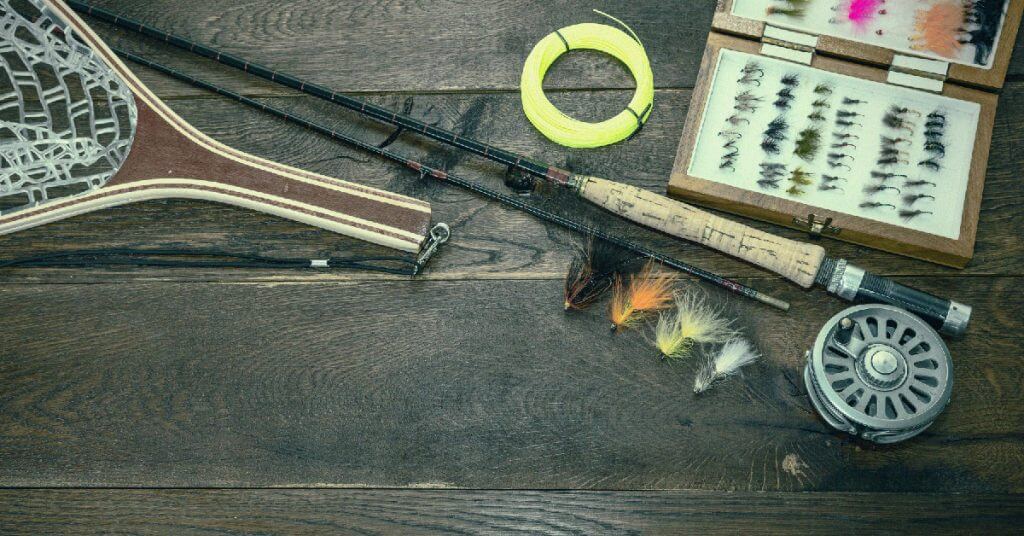

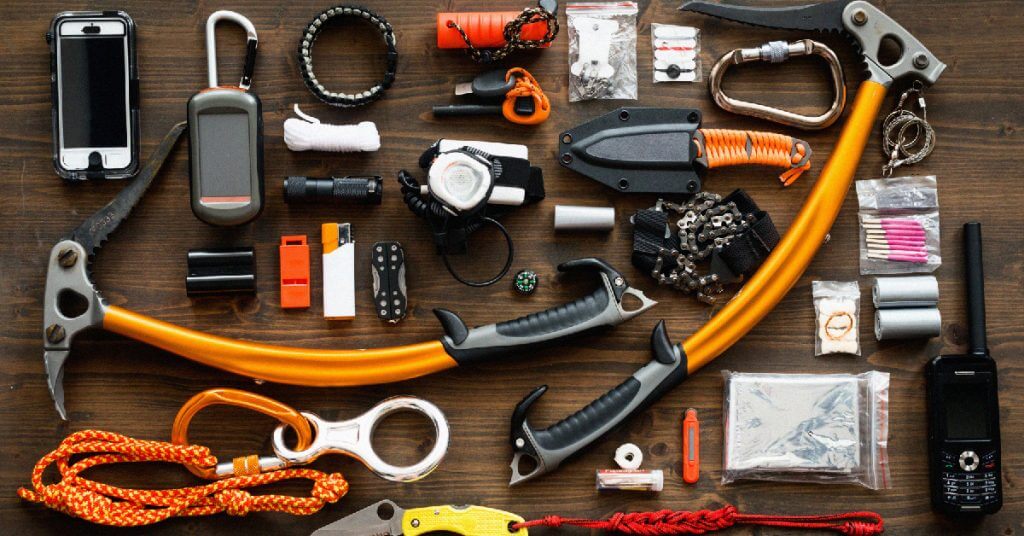
Great article, Coty. A lot of food info here.
That should be “good” not “food.” LOL
Thanks Timothy – I want to start putting together more survival fishing related content. Definitely gonna check out your blog!
Nice! Will save article.
As I know zip about fishing, I got a lot out of this piece. One of your most valuable tips has less to do with fishing and everything to do with surviving–your point about practicing before you have an emergency. There’s no comparison between thinking about what you would do, and actually doing it.
Thanks for the excellent post.